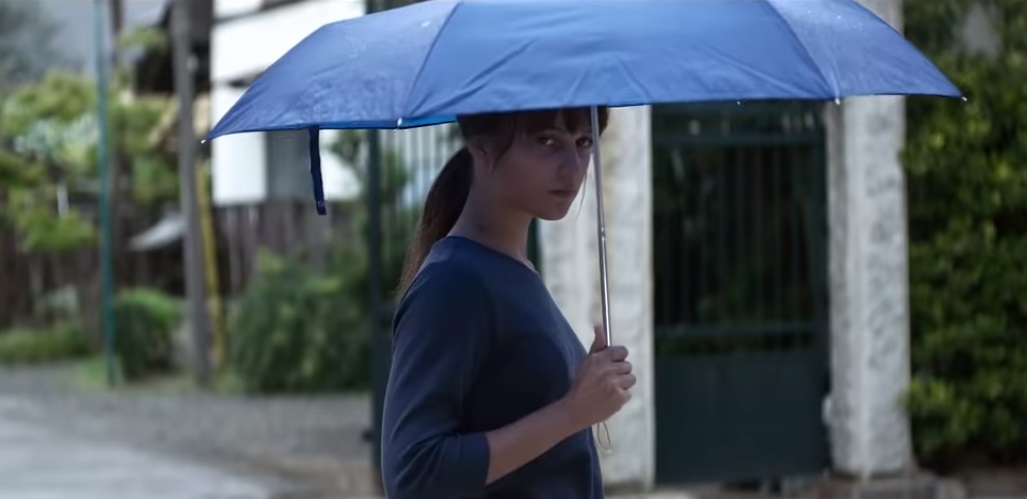Directed by Wash Westmoreland, Netflix’s film, ‘Earthquake Bird,’ is not the kind of crime drama that will keep you at the edge of your seat at all times with its looming mysteries; instead, it is more of an atmospheric psychological noir that engrosses you with its gritty and bleak setup. The film is set in 1980s Tokyo and centers on a young ex-pat English translator, Lucy Fly (Alicia Vikander), who gets interrogated by the Japanese police for the murder of her friend, Lily.
Almost like the pages of her personal memoir, what follows is Lucy’s own interpretation of the events that eventually led to Lily’s death. It all begins with a love triangle when Lily ingratiates herself with Lucy’s love obsession, Teiji. Driven by jealousy and guilt, Lucy starts losing her mind as everything around her falls apart. Damped with visuals of bullet trains, mountains, and monasteries of the island nation, the film actually makes you want to visit Japan yourself. So here’s everything we know about its filming locations.
Earthquake Bird Filming Locations
Toho Studio, Tokyo
Most scenes of the film have been shot in around Japan’s renowned Toho Studio which is headquartered in Yūrakuchō, Chiyoda, Tokyo. Many of the classic ‘Godzilla‘ movies have also been shot here.
Keisei Electric Railway and Kintetsu Railway, Japan
The film starts off with an abutting shot of the main character stepping out of an electric train and then somewhere in the corner, it also focuses on a poster on the wall that reports Lily missing. Much later in the film, there’s one scene where Lucy and Lily are dropped off at a railway station by Teiji, and soon after this, Lucy gets an outbreak of vivid hallucinations, and she imagines Lily on the other side of the platform. Both of these scenes were shot on the Keisei Electric Railway and the Kinentsu Railway of Japan.
Sado Island, Niigata, Japan
Much later, Lily, while drawing Lucy and Teiji into her own world, takes them to the picturesque location of Sado Islands, where they visit the coast and the cliffs of Senkaku. This is where Lucy falls sick, and Teiji and Lily end up leaving her behind to explore the other parts of the Island. Soon after this, she finds them in the Gold Mine in Aikawa, and out of jealousy, she affronts them for leaving her behind.
Apart from this, the film also walks you through a checklist of other renowned Japanese tourist spots, such as Mount Fiji, Tokyo Tower, and even several karaoke bars in Tokyo. Since all the filming took place in Japan, the flashbacks that Lucy recalls from her past are not set in North England and, instead, have been shot on the film’s set in Tokyo itself. To a large extent, nothing much is revealed about the locations of the film and this has been done intentionally to make sure that, as a viewer, you feel as lost as the protagonist in a distant country.
Since the history of modern Tokyo largely deals with how the neon-lit capital has dealt with several catastrophes in the past, ‘Earthquake Bird’ also presents several moments wherein, almost like a vivid nightmare, the characters find themselves in the middle of an earthquake. But instead of polishing this with some glamorized action, everything is portrayed in a muffled tone that very well reflects the realities of the archetypical modern metropolis.
This looming awareness of naturally occurring disasters in the capital has in itself elevated a sense of life’s transience in the minds of those who live there. And because of this, Tokyo is sporadically exposed to many capricious styles and trends. Because of the ambiguity of its culture, the city often comes off as a kaleidoscopic picture to most filmmakers. Unsurprisingly, despite how futile their attempts might seem to encapsulate the essence of the city, many of them have attempted to explore the richness and mysteriousness of the mores of its society. Some of these films include ‘Kill Bill‘, ‘The Wolverine‘, ‘Fast and Furious: Tokyo Drift‘, and of course, ‘Lost in Translation‘.
Compared to many of these films, ‘Earthquake Bird’ draws a fairly realistic picture in context with capturing the gridded streets and the urban complexities of Tokyo. It also explores other areas in and around the city while it subtly instigates the dense sprawling culture of the region.
Read More: Earthquake Bird Review

